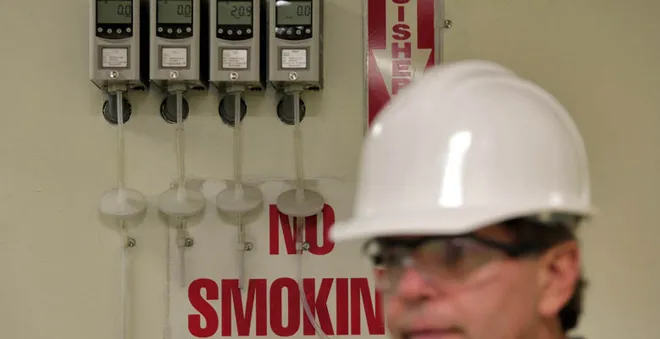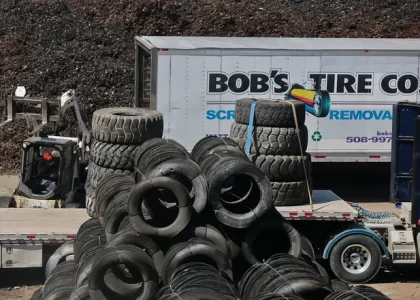NEW BEDFORD — More than two months have passed since a mysterious toxic release at New Bedford Waste Services sent Adrian Mejia to St. Luke’s Hospital in critical condition.
Mejia, who spent nine days in the hospital, continues to suffer from health problems that prevent him from returning to work at the Shawmut Avenue construction and demolition recycling plant.
The Guatemalan Mayan, who lives in Providence, suffers daily from blurry vision, shortness of breath, dizziness and nausea that has caused him to shed 18 pounds since the accident. He makes weekly trips to the doctor for lung therapy.
Overall, 120 workers and first responders were sent to area hospitals for decontamination. While most of the people who required treatment were released the same day, a handful — including Mejia — were hospitalized for several days.
While the 48,000-square-foot plant quickly returned to its routine following the incident, state and federal agencies continue to investigate what went wrong on Aug. 3.
State environmental agents are still investigating the nature and source of the toxic substance that triggered the Tier 4 hazardous materials situation. A state hazmat team concluded that the release was almost instantaneous and did not spread beyond the plant.
The release caused several New Bedford Waste Services workers and emergency personnel to experience immediate symptoms of respiratory distress, nausea and watery eyes.
The hazmat team, which spent hours investigating the plant after the incident, was unable to detect elevated levels of chemicals or lingering residue.
New Bedford Fire Chief Paul Leger said it was possible the toxic substance might never be identified because it dissipated so quickly. “It was gone by the time they had gotten there with their equipment,” he said.
And now the owner of the company, Michael Camara, is claiming that the toxic gas did not originate in his plant.
Camara said his insurance company sent a certified industrial hygienist to the plant to investigate the cause of the toxic release. The investigation concluded that New Bedford Waste Services was not the source, he said.
“It didn’t happen on this property,” Camara said. “Something came in the back door. Something freaky happened and what it was we don’t know,” he said.
The back door of the plant opens to a small yard bordered by a fence. Behind the fence, there is marsh land and the city-owned Shawmut Avenue landfill.
“Could it have come from the marsh land or the landfill? I don’t know,” Camara said during a tour of the plant.
He noted that interviews conducted by the company’s human resources department found workers at different buildings along Shawmut Avenue who noticed a strange smell or metallic taste in their mouth the morning of the toxic release.
The state Department of Environmental Protection is still investigating the cause of the release and has not reached a final conclusion, agency spokesman Joe Ferson said.
“There was no monitoring data that indicated there was a landfill gas migration problem,” he said.
DEP investigators required New Bedford Waste Services to submit a report, which must “identify the source and the actions taken to prevent similar incidents,” Ferson said.
“We did receive (the report) and are reviewing it,” he said.
Three days after the incident, the plant, which processes about 1,000 tons of construction and demolition debris each week, reopened full-time.
The company employs about 20 people, Camara said. Some workers, such as Mejia, are temporary workers employed directly by B.J.’s Temp Services Inc. of New Bedford.
Mejia, who speaks Quiche and some Spanish, told his story to a Standard-Times reporter through an interpreter.
At New Bedford Waste Services, Mejia worked in the plant’s second-floor picking room, where he sorted wood, cardboard, asphalt, brick, concrete and other construction and demolition debris as it passed by on a conveyor belt. He said he remembers very little from the morning of Monday, Aug. 3.
According to a company official, Mejia was walking out of a downstairs bathroom when he was overcome by an unknown substance. He passed out in a narrow hallway near a stairwell leading down to the plant’s open back door.
Mejia said he felt a sensation that bees were stinging him all over his body. There was a sense of freezing cold. The next thing he remembers is waking up in the hospital with a nurse looking over him.
Among the 120 people sent to area hospitals, Mejia and Luis Vega, who tried to help the fallen Mejia, suffered the most severe reactions. Both were placed on ventilators at St. Luke’s Hospital, where they were initially listed in critical condition. Vega has since returned to his job at the plant.
Mejia said he worked at New Bedford Waste Services for a year and two months prior to the toxic release.
Since the accident, he has been receiving workers’ compensation benefits — as he is entitled to under the Massachusetts Workers’ Compensation Act — through Travelers Insurance, said Fall River attorney Deborah G. Kohl. The act provides monetary benefits, medical care and rehabilitation services to injured workers.
On the day a Standard-Times reporter toured the plant, there were no temporary workers sorting debris in the picking room. Camara said the workers were absent because there was not enough material to process. A handful of workers operated trucks on the tipping floor, where sprinklers sprayed mist over huge piles of debris to contain dust.
Camara said “safety is a big concern” at the plant. He said gloves and masks are handed out to workers each morning. A sign in the picking room warns workers that safety glasses are required. Workers on the tipping floor — a giant garage where trucks dump debris — are required to wear a hard hat, safety glasses and fluorescent safety vests, Camara said.
Since the incident, Camara said the company has installed a $30,000 gas detection system in the hallway where Mejia collapsed. The back door is now kept closed and signs posted in both English and Spanish command workers to keep it shut.
“We put in a system to detect any gases that may come in the building from the outside,” Camara said. “We want to make sure we catch it.”
He said the workers used to keep the door open every summer to allow air to flow up the stairwell to the picking room.
Fire Chief Leger said his department worked with New Bedford Waste Services on the detection system and a revised evacuation plan for workers.
“We are happy that they’ve put in these alarm systems. “¦The bottom line is we just don’t want to have another incident occur,” he said.
The federal Occupational Safety and Health Administration is continuing its separate investigation into what happened at the plant. The OSHA review is “strictly looking at worker safety and health standards in that workplace,” agency spokesman Ted Fitzgerald said. The investigation remains open, but must be completed within six months of the incident, he said.
Such investigations can involve worksite inspections, record reviews and interviews with workers and managers, Fitzgerald said. OSHA may issue citations and fines to employers who are found to have violated workplace safety and health standards.
In early September, an OSHA investigator interviewed Mejia and other workers who were at New Bedford Waste Services on the day of the toxic release. The interviews were conducted at Centro Comunitario de los Trabajadores, a new community center for immigrant workers in the South End.
During an interview the same day, Mejia told The Standard-Times that he was neither wearing gloves nor a face mask on the day of the toxic release.
Following the incident, workers’ rights advocates called for greater oversight over the state’s waste disposal and recycling facilities.
The industry is seen in a positive light since consumers feel they are doing the right thing for the environment by recycling, said Corinn Williams, executive director of the Community Economic Development Center of Southeastern Massachusetts.
“Recycling is a good thing, but at the same time you have to be aware about what happens once the blue bin leaves the sidewalk,” she said. “We want to make sure that people who are handling the recycling are kept safe. There needs to be some monitoring of how recycling and trash is handled. So far, there is not a lot of attention given to that.”




